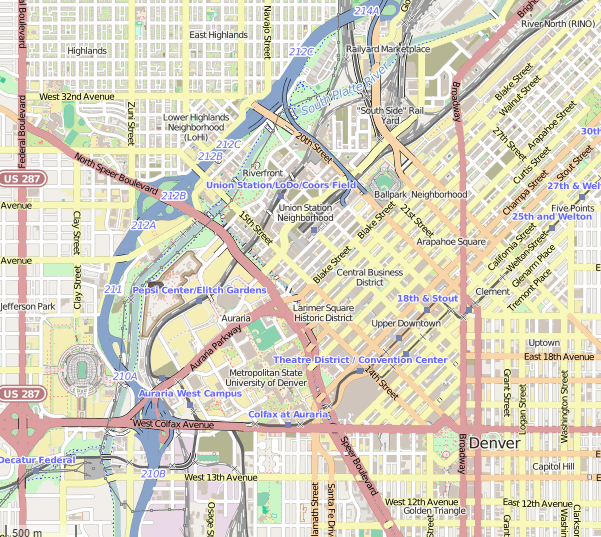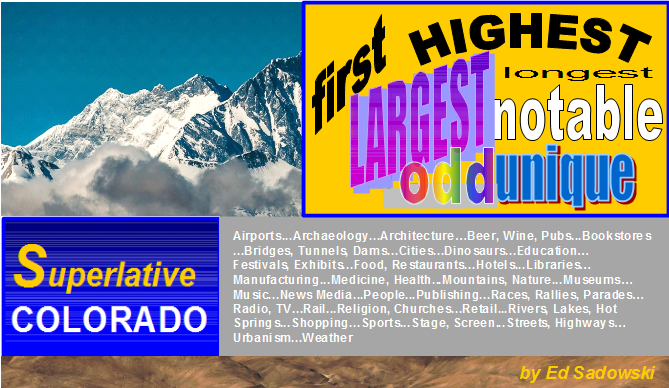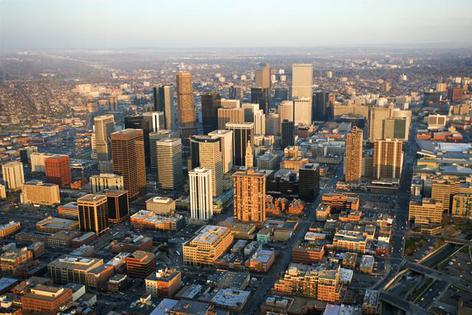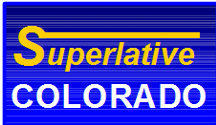Map: © OpenStreetMap contributors
Another Ed Sadowski creation
ED SADOWSKI
BEER
Airports...Archaeology...Architecture...Art...Beer, Wine, Pubs... Bookstores...Bridges, Tunnels, Dams...Churches, Religion... Cities... Dinosaurs... Education...Events, Festivals...Food, Restaurants..Hotels... Libraries... Manufaturing...Health, Medicine...Mountains, Nature... Museums... Music...News media...People...Publishing...Races, Rallies, Parades...Radio, TV...Rail transit...Retail...Rivers, Lakes, Hot Springs...Sports...Stage, Screen...Streets, Highways, Infrastructure... Urbanism...Weather, Climate
Downtown
Denver
BEER
Coors Field
Great American Beer Festival
LoDo
Wynkoop Brewing Co.
Denver and Colorado lay claim to being the beer capitals of the nation for good reasons. Colorado has the moniker of being the "Napa Valley of beers": it outshines all other states in being at or near the top in a number of beer categories.
Denver brews more beer than any other metropolitan area in the United States, making it, from that standpoint, America’s No. 1 beer city. Denver is one of the premier cities for the number of brewpubs and microbreweries. The Wynkoop Brewing Company, in Denver's LoDo, at one time was the nation's largest microbrewery in terms of volume, and helped launch the country's brewpub craze in the 1980s, which has carried on through today. Boulder has the most breweries per capita, and Fort Collins is third, adjusted for population.
Colorado's MillerCoors, Budweiser, and microbreweries produce more beer than any other state. Only California, with a much larger population, has more microbreweries than Colorado. And Denver has the second-largest number of breweries in the nation, second only to Chicago, which has a much larger population. Colorado is in the top five for states with the most microbreweries per capita and overall production. The Golden site of MillerCoors, the nation's largest brewing facility, has for many years had the world's largest single brewery in the world (a couple of breweries in Mexico are now vying for that title).
5
Denver's Great American Beer Festival has become the world's premier event of its type, where more beers are on tap than any other place in the world, showcasing over 3,500 different brews, representing a world record of over 700 brewers. Colorado has consistently won the second most (next to California) brewing competition prizes at the World Beer cup, "the Olympics of Beer Competition," the most prestigious beer competition in the world.
How times have changed, when we contrast Denver’s love affair with beer to a 1932 Time magazine article that stated, “Denverites drink bad whisky and gin, and little beer.”
Coors Field //////////////////////////////////////////////////////
W. 13th Ave. and Broadway
Coors Field was completed in 1995, becoming home to the Colorado Rockies National League baseball club, after playing two years in Mile High Stadium, where all-time major league baseball attendance records were set. At 5,200 feet (1,580 m) above sea level, Coors Field is by far the highest ballpark in major league baseball. Coors Field has been described as “the most exciting park in baseball history,” “the most home-run friendly park,” “the worst park to pitch in,” borne out by major league records, including producing the most home runs, triples and doubles ever in a season. This superlative offensive production is ascribed not only to the altitude but also to Coors Field having the largest outfield in the majors. On April 23, 2013, the Rockies and Braves played in the coldest major league game-time temperature ever officially recorded, at 23 °F (−5 °C). Perhaps not coincidentally, Coors Field was the first major league park with an underground heating system.
Coors Field superlatives include firsts for its 2014 Rooftop addition done by the Denver-based construction and design teams headed by Mortensen Construction and Populous and ME Engineering. The innovative two-level Rooftop at Coors Field, on the upper right field deck, provides a new revenue-generating space--a unique rooftop bar--attracting an entirely new group of fans, available as a separate admission or as part of the general admission. The standing-room only space features craft beer, local food, spaces to socialize and views of the game, the city, and the Rocky Mountains. Coors Field is the first major sports venue to re-purpose a major portion of a facility (3,500 seats converted to 46,00 square feet of rooftop space) into a rooftop deck, having created at that time the largest deck or patio in professional sports. Mechanical contractor RK Mechanical played a key role in overcoming construction challenges in the project, earning it an Award of Excellence trophy by the Associated Builders and Contractors Excellence in Construction.
The team’s colors include the only use of purple in major league baseball, which covers caps, jerseys, jackets, protective gear and even printed and digital promotional materials. It makes perfect sense, in deference to "For purple mountain majesties" in Katherine Lee Bates' lyrics for "America the Beautiful." The Rockies' purple started initially as an accent color, but now is a prominent part of the team's color scheme together with black, silver and white, most notably exemplified in the team's solid purple alternate jersey. At the start of the 2012 season, the Rockies introduced "Purple Mondays" in which the team wears its purple uniform every Monday game day. In 2017, the club's official purple was changed to a lighter tone because its previous shade often appeared blue under certain lighting conditions.
During construction in 1994, a highly unusual occurrence: workers discovered a number of dinosaur fossils throughout the grounds: a Cretaceous-era dinosaur egg, an unidentified dinosaur rib, and the crown-jewel, a 7-foot-long, 1,000-pound Triceratops skull. Fittingly, the team mascot was chosen to be Dinger, the purple dinosaur.
In 1995 Coors Field was the first ballpark to have its own (on-site) brewery, the award-winning Blue Moon Brewing Company at the Sandlot, started by the Coors Brewing Co. The MillerCoors-owned brewpub is located in the ballpark at 22nd and Blake, open to the public during the baseball season. Inside the ballpark, Blue Moon Brewery is located at the Sandlot on the main concourse of Coors Field behind Section 112 in the right field corner.
Its signature beer, Blue Moon Belgian White, considered the most successful and largest selling "craft" beer, was created here, and has won multiple medals at the Great American Beer Festival. (Its other award-winning brews include Summer Honey Wheat, Harvest Pumpkin Ale and Agave Blonde Ale.)
The Sandlot brewery is the world's first macrobrewery (Coors)
production of a successful "craft" beer, the originator of the first commercial "craft" beer and one of the world's most influential "craft breweries." "Craft" is in quotations here, because, marketed as a craft brewery, this beer does not meet the criteria of many beer purists as well as the Brewers Association strict definition of a craft brewery. This marketing strategy controversy was brought up in a California lawsuit, where a Federal court ruled that Coors' use of the Sandlot and Blue Moon Brewing Co. names met the legal requirements of the use of fictitious trade names and was not a deceptive consumer practice.
The Great American Beer Festival //////////////////////
at the Colorado Convention Center
The Great American Beer Festival in Denver showcases the largest variety of beers of any beer festival in the world. When it was started in 1982 by the Colorado-based Brewers Association, it was the first-ever national beer-judging event and now is the premier event of its kind.
The three-day annual fall Festival held in the Colorado Convention Center represents a world record beernanza of over 700 American brewers and 3,500 kinds of beer imbibed by 30,000 quaffers. Over 100 medals are awarded by professional tasters to the best brews. The Great American Beer Festival is listed as one of the top 1,000 places in the U.S. to visit before you die.
Lower Downtown (LoDo) ////////////////////////////////
LoDo and beer are inseparable phenomena.
Lower Downtown (LoDo) is Denver's oldest historic district, an area that developed around the railroads of the new city, consisting of stores, hotels, warehouses and mercantile buildings. The thoroughly run-down area was slated for demolition by the Denver Urban Renewal Authority (DURA) in the 1960s and 1970s. Preservationists put a halt to this action, but not until about 20 percent of the buildings had been demolished.
Today the 26-block district consists of 127 historic structures, one of the country's largest concentrations of Victorian and early twentieth-century buildings. The buildings have become a part of the district's transformation into a vibrant, thriving area of businesses and residences. A LoDo zoning ordinance has placed limitations on building height and strict design guidelines for renovation and new construction.
The area full of old-world charm brick buildings has become trendy and gentrified, home to art galleries, brewpubs, boutiques, and technology startups. In the late 1980s Wynkoop Brewing Co. helped launch the craft brewing craze that has spread worldwide. In the 1990s LoDo had the highest number of microbreweries of any urban district. New apartment and condo buildings have sprung up, as well as boutique hotels. The building of Colorado Rockies ballpark Coors Field in LoDo in 1995 was a major catalyst for the area's revival along with the 1999 addition of concert and sporting venue Pepsi Center.
Wynkoop Brewing Co. /////////////////////////////////////////
A legendary, revered icon of brewpubs—for a decade the Wynkoop Brewing Company was the granddaddy of microbreweries, ruling as the nation’s largest microbrewery, selling the largest volume of beer in its LoDo brewpub. In the late 1980s Wynkoop Brewing Co. helped launch the craft brewing craze that has spread worldwide.
Started in 1988 in the historic J.S. Brown Mercantile Building by former Denver mayor and Colorado governor John Hickenlooper and three partners, Wynkoop Brewing Co. was Denver's first craft brewery, helping establish Colorado as the country's beer capital and Napa Valley of beer. Best known for its Oktoberfest brew, Scottish ale and small-batch beers, the brewery offers free tours to groups.
Partner and renowned brewmaster Russell Schehrer was one of the first professional brewers in the country to produce mead, doppel alt, and cream stout. The Brewers Association has recognized Schehrer with the creation of the Russell Schehrer Award for Innovation in Brewing, awarded at the yearly Craft Brewers Conference.



